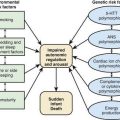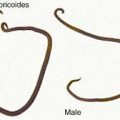Chapter 195 Yersinia
195.1 Yersinia enterocolitica
Differential Diagnosis
The clinical presentation is similar to other forms of bacterial enterocolitis. The most common considerations include Shigella, Salmonella, Campylobacter, Clostridium difficile, enteroinvasive Escherichia coli, Y. pseudotuberculosis, and occasionally Vibrio diarrheal disease (Chapter 332). Amebiasis, appendicitis, Crohn disease, ulcerative colitis, diverticulitis, and pseudomembranous colitis should also be considered.
Abdel-Haq NM, Asmar BI, Abuhammour WM, et al. Yersinia enterocolitica infection in children. Pediatr Infect Dis J. 2000;19:954-958.
Abdel-Haq NM, Papadopol R, Asmar BI, et al. Antibiotic susceptibilities of Yersinia enterocolitica recovered from children over a 12-year period. Int J Antimicrob Agents. 2006;27(5):449-452.
Bottone EJ. Yersinia enterocolitica: overview and epidemiologic correlates. Microbes Infect. 1999;1:323-333.
Jones TF, Buckingham SC, Bopp CA, et al. From pig to pacifier: chitterling-associated yersiniosis outbreak among black infants. Emerg Infect Dis. 2003;9:1007-1009.
Ray SM, Ahuja SD, Blake PA, et al. Population-based surveillance for Yersinia enterocolitica infections in FoodNet sites, 1996–1999: higher risk of disease in infants and minority populations. Clin Infect Dis. 2004;15(38 Suppl 3):S181-S189.
Wesley IV, Bhaduri S, Bush E. Prevalence of Yersinia enterocolitica in market weight hogs in the United States. J Food Prot. 2008;71(6):1162-1168.
Zheng H, Sun Y, Lin S, et al. Yersinia enterocolitica infection in diarrheal patients. Eur J Clin Microbiol Infect Dis. 2008;27(8):741-752.
195.2 Yersinia pseudotuberculosis
Y. pseudotuberculosis has a worldwide distribution; Y. pseudotuberculosis disease is less common than Y. enterocolitica disease. The most common form of disease is a mesenteric lymphadenitis that produces an appendicitis-like syndrome. Y. pseudotuberculosis is associated with a Kawasaki disease–like illness in about 8% of cases (Chapter 160).
Jalava K, Hakkinen M, Nakari UM, et al. An outbreak of gastrointestinal illness and erythema nodosum from grated carrots contaminated with Yersinia pseudotuberculosis. J Infect Dis. 2006;194(9):1209-1216.
Matero P, Pasanen, Laukkanen R, et al. Real-time multiplex PCR assay for detection of Yersinia pestis and Yersinia pseudotuberculosis. APMIS. 2009;117(1):34-44.
Press N, Fyfe M, Bowie W, et al. Clinical and microbiological follow-up of an outbreak of Yersinia pseudotuberculosis serotype Ib. Scand J Infect Dis. 2001;33:523-526.
Wren BW. The yersiniae—a model genus to study the rapid evolution of bacterial pathogens. Nat Rev Microbiol. 2003;1(1):55-64.
195.3 Plague (Yersinia pestis)
Etiology
Y. pestis is a gram-negative, facultative anaerobe that is a pleomorphic nonmotile, non-spore-forming coccobacillus and is a potential agent of bioterrorism (Chapter 704). The bacterium has several chromosomal and plasmid-associated factors that are essential to virulence and to survival in mammalian hosts and fleas. Y. pestis shares bipolar staining appearance with Y. pseudotuberculosis and can be differentiated by biochemical reactions, serology, phage sensitivity, and molecular techniques. The Y. pestis genome has been determined and is ~4,600,000 base pairs in size.
Differential Diagnosis
Pulmonary manifestations of plague are similar to those of anthrax, Q fever, and tularemia, all agents with bioterrorism and biological warfare potential. Thus, the presentation of a suspected case, and especially any cluster of cases, requires immediate reporting. Additional information on this aspect of plague and procedures can be found at www.bt.cdc.gov/agent/plague/.
Treatment
Postexposure prophylaxis should be given to close contacts of patients with pneumonic plague. Antimicrobial prophylaxis is recommended within 7 days of exposure for persons with direct, close contact with a pneumonic plague patient or those exposed to an accidental or terrorist-induced aerosol. Recommended regimens include a 7-day course of tetracycline, doxycycline, or TMP-SMX. Contacts of cases of uncomplicated bubonic plague do not require prophylaxis. Y. pestis is a potential agent of bioterrorism that can require mass casualty prophylaxis (Chapter 704).
Barde R. Plague in San Francisco: an essay review. J Hist Med Allied Sci. 2004;59(3):463-470.
Boulanger LL, Ettestad P, Fogarty JD, et al. Gentamicin and tetracyclines for the treatment of human plague: review of 75 cases in New Mexico, 1985–1999. Clin Infect Dis. 2004;38(5):663-669.
Brubaker RR. The recent emergence of plague: a process of felonious evolution. Microb Ecol. 2004;47(3):293-299.
Centers for Disease Control and Prevention. Two cases of human plague—Oregon 2010. MMWR. 2011;60(7):214.
Centers for Disease Control and Prevention. Bubonic and pneumonic plague—Uganda, 2006. MMWR. 2009;58:778-781.
Centers for Disease Control and Prevention. Imported plague—New York City, 2002. MMWR. 2003;52:725-727.
Dennis DT, Chow CC. Plague. Pediatr Infect Dis J. 2004;23(1):69-71.
Duncan CJ, Scott S. What caused the Black Death? Postgrad Med J. 2005;81(955):315-320.
Hinnebusch BJ. The evolution of flea-borne transmission in Yersinia pestis. Curr Issues Mol Biol. 2005;7(2):197-212.
Prentice MB, Rahalison L. Plague. Lancet. 2007;369(9568):1196-1207.
Zhou D, Yang R. Molecular darwinian evolution of virulence in Yersinia pestis. Infect Immun. 2009;77:2242-2250.







